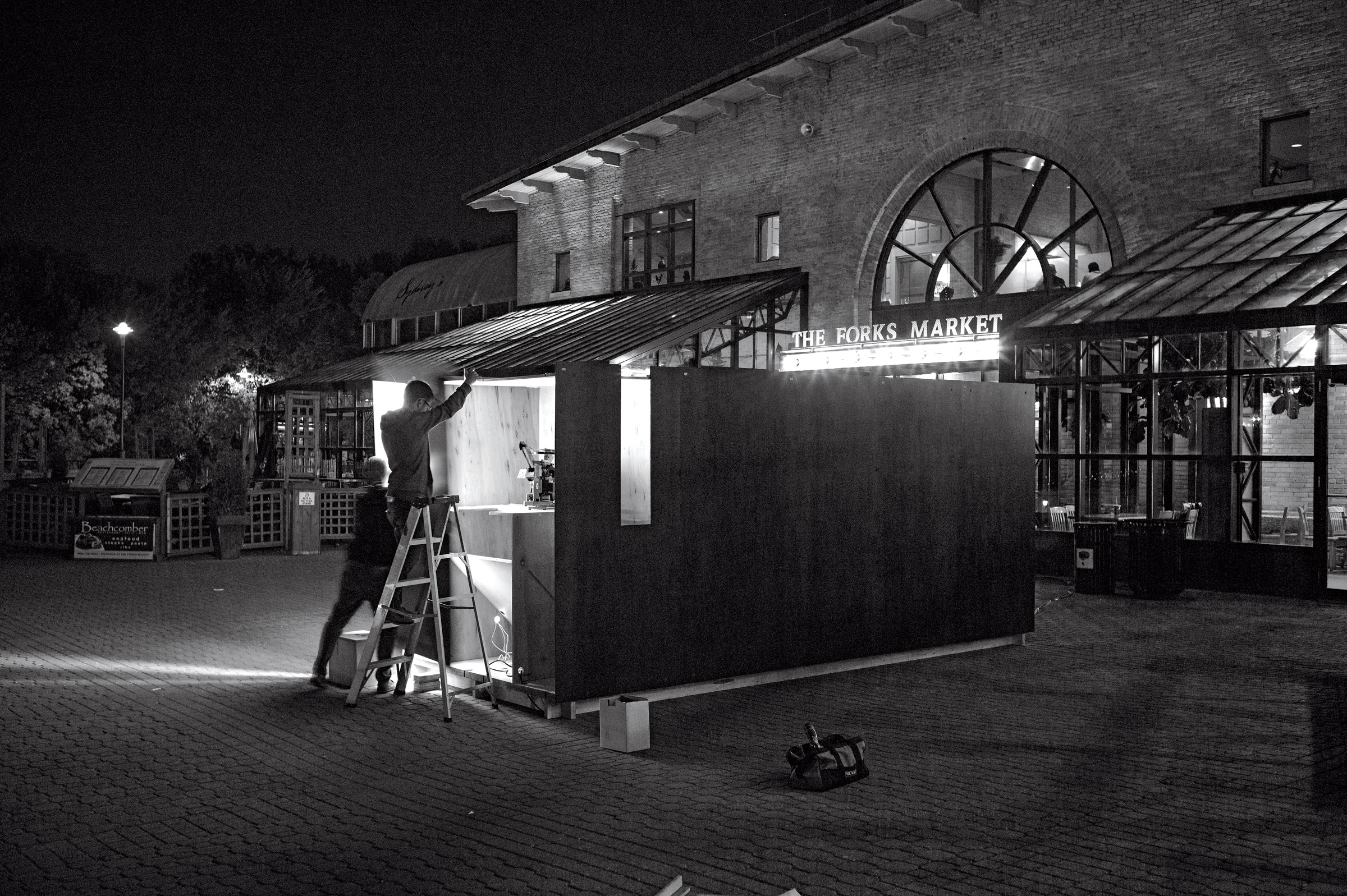Thresholds Issue ❷ ↓ Insights

“So this is like a mushroom, it pops up? A creative mushroom. I love it!” enthused the woman in her forties, dressed from head to gumboots in orange. She had just emerged from the Situated Cinema, a ‘demountable micro-cinema’ that was moving around Winnipeg for the four days of WNDX, an experimental film festival.
A matte black box made of interlocking wooden panels, which took two hours to put up and an hour to take down from its flat-packed state, the Situated Cinema was created by Tom Evans, Solomon Nagler, Craig Rodmore and Will Vachon to show short art films about cities, in public places in the city. What I, as an urban anthropologist, was trying to find out was how members of the public engaged with the Situated Cinema in urban space. I hung out all day at each place the Situated Cinema was put up to observe how people approached this strange, intimidating structure, and interviewed them afterwards about their experience of it.
Not much is known about what public art does for cities and city dweller, although many claims are made about it. Geographer Martin Zebracki calls the more utopian claims ‘public artopia’. For instance, urban planners and policy-makers might say that public art makes sites more attractive, draws tourists, consumers or ‘creative class’ workers, fosters social connections, or raises awareness of local history or civic identity. Meanwhile, artists’ rationales for their works typically speak to their peers and critics in the contemporary art world. But there is much to learn about how public art installations are reacted to, or interacted with, by ‘ordinary’ people. That’s why I wanted to see how the Situated Cinema affected the sites where it was put up, and how those who encountered it received it.
Public art takes many forms. There’s the traditional hero-on-a-horse in a public square, or modern sculpture in a plaza. Some critics call this ‘plop art’, because it seems to be plonked down with no regard for its surroundings. Other forms are more site-specific, though there are different ways of tailoring art to a site. It might blend in or stand out. It might be central and unavoidable (like Richard Serra’s Tilted Arc, a big steel sculpture that disrupted people’s pathways through Foley Federal Plaza in Manhattan, generating so much controversy that it was removed), or off the beaten path (as the Situated Cinema was for one day of its exhibition).
A lot of public art these days is framed by city-wide arts festivals (one night, the Situated Cinema was part of Winnipeg’s Nuit Blanche). These festivals pose a conundrum about art in cities. On one hand, they create new venues and audiences, but on the other, they suck up a lot of resources for short-term entertainment. This risks making the artworks yet another thing to consume one piece after another like a giant art buffet, pleasing the crowds instead of surprising them with something to really make them think. Shouldn’t art be just a little destabilizing?
Anthropologist Ellen Dissayanake writes that art is really about ‘making special’—it helps us acknowledge the extraordinary. In many cities, resources are put into making public spaces ‘special’ through art. Yet, the ‘special’ in art doesn’t have to mean ‘difficult’. I found that people had lots to say about the Situated Cinema, even if they didn’t quite grasp the experimental films shown in it. The clever structure had them stepping through the beam of light from the projector on the way to the screen. This reminded them of old-style cinemas and the days when communities gathered in them to watch the news. Some people thought of peepshows or kinetoscopes, probably because the Cinema was so small. One woman said it was like “your own private little booth”. A man joked, “Where’s the coin slot?” Interestingly, this theme echoed the intentions of the Situated Cinema’s creators and filmmakers, although they expressed it in more technical, expert language. They wanted the design of the building and the films to draw attention to the mechanics of production of cinema and celluloid film, a near-obsolete medium that was a challenging material to work with.
This kind of connection between the creators’ intentions and the public’s reception of an artwork should not be taken for granted. Some public art repels its audience, or gets subverted by them–used for something other than its intended purpose. Another public art installation I’ve studied displayed text messages sent in anonymously by members of the public, and—like toilet stall graffiti—a lot of those messages were obscene. Some might argue then that such art shouldn’t go up, but people’s reactions to art can’t be controlled or predicted—all the more so when the art is in public. When art is viewed in a gallery, people tend to keep their opinions to themselves, but out in the city they feel freer to comment on or interact with it (especially if others are reacting to it as well). This can get very critical, playful, or even downright rude—which may be a reason why it’s not often studied. But that’s a risk worth taking as we try to understand what makes public art ‘public’—not to mention what makes public art ‘art’. ●
—
Martha Radice is an associate professor of social anthropology at Dalhousie University, Halifax. martha.radice@dal.ca
_
The Demountable Cinema was part of a series of experimental projects exploring the relationships between architecture and cinema by artists and designers Thomas Evans, Craig Rodmore, Will Vachon, Paul Zylstra, Solomon Nagler, Samantha Bruegger, Melissa Schwegmann, Jonathan Mandeville, and students from the School of Architecture at Dalhousie University.